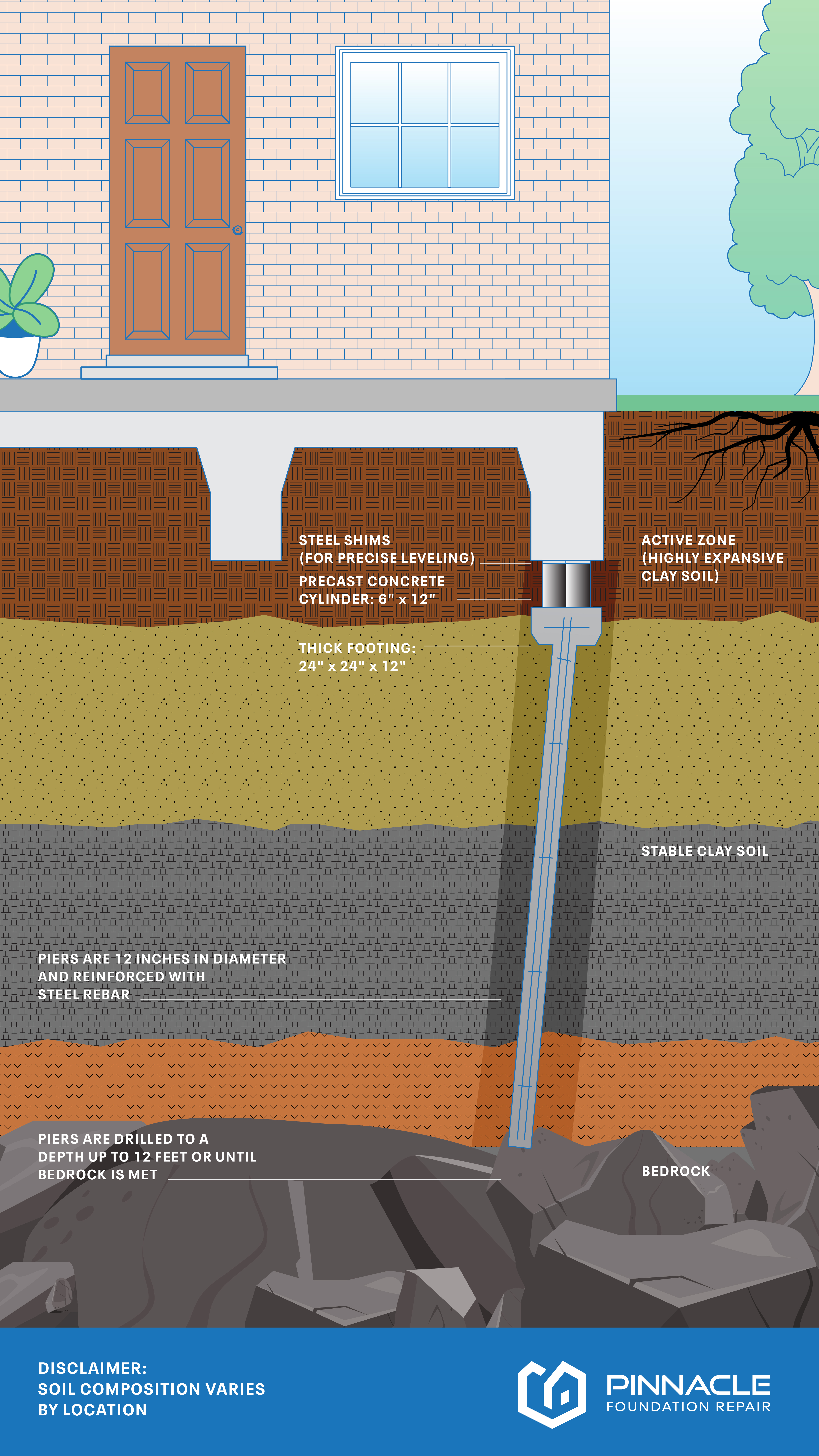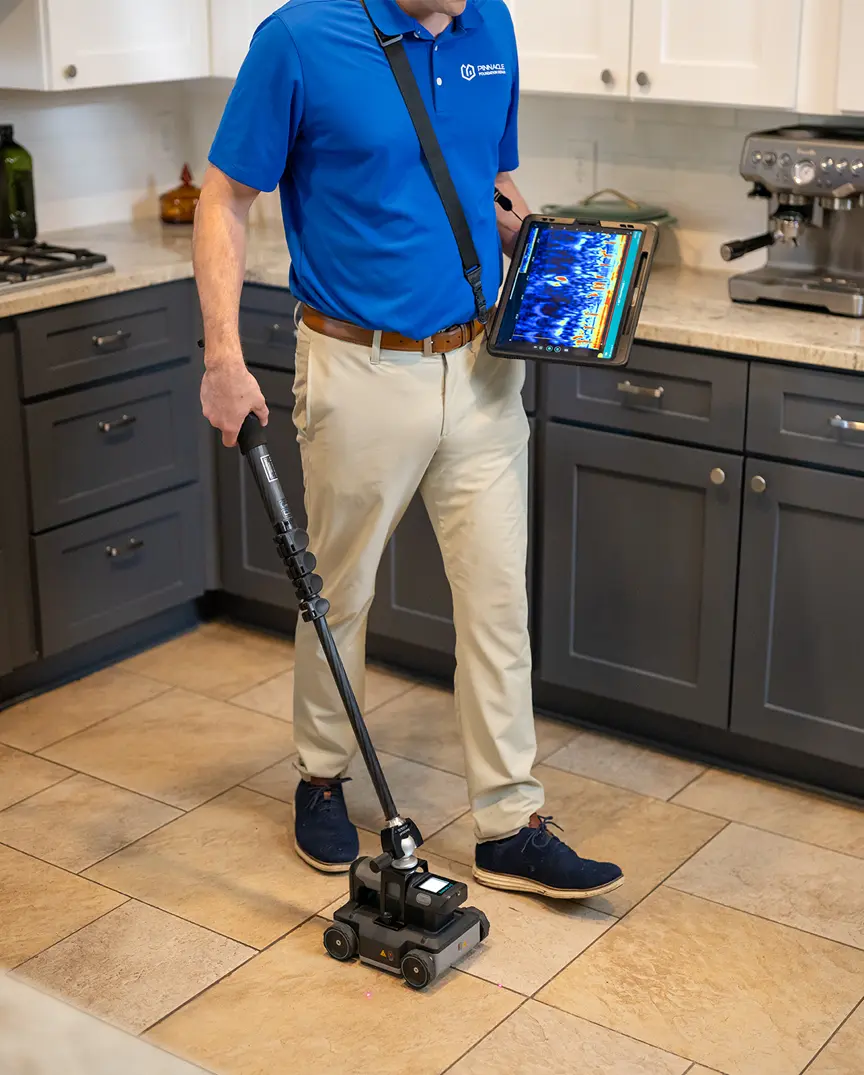Drilled Piers
Subterranean Stabilizers: Engineering Support from Below
10-YEAR WARRANTY
Contact Us
If you have any query about our service please contact with us

Drilled piers are an ideal foundation repair solution, particularly for lightweight or older structures where vibrations from hydraulic presses could cause damage. Reinforced with rebar and a five-sack concrete mix, these 12-to-18-inch wide concrete piers provide robust support and stability, reaching depths of up to 12 feet into the ground. Drilled piers offer exceptional load-bearing capacity and work great in various soil conditions, including in rocky and clay-heavy soil.
Fun Fact: Drilled piers go by many names in the foundation repair industry, including caissons, drilled shafts, belled piers, bell-bottom piers, cast-in-drilled-hole piles (CIDH piles), or cast-in-situ piles. Now you know!
How are Drilled Piers Installed?
- A powerful auger (a huge drill tool) is used to bore holes up to 12 ft deep where needed under the foundation
- A cage of steel rebar reinforcement is carefully installed into each hole
- We fill the entire drilled shaft cavity with high-quality concrete
- It takes between five to seven days for the concrete to fully cure and set
- Foundation fixed! Reliable and radically precise – the Pinnacle way!
Pros and Cons of Drilled Piers for Foundation Repair
Pros:
Ideal for Lightweight Structures: Drilled piers are perfect for light structures, where using a hydraulic press could risk damage.
Versatile Excavation: Auger drills allow efficient excavation of drilled piers in all soil types.
Belled Piers for Tough Soils: In cases where the soil lacks proper bearing capacity, we use belled piers (explained below). These feature an under-reaming tool for a stable base in challenging soil conditions.
Exceptional Load-Bearing: Drilled piers offer unmatched load-bearing capacity, ensuring stability and durability for structures.
Steel Reinforcement: Each drilled pier is reinforced with steel for added strength and stability, ensuring optimal performance in various soil conditions.
Cons:
Depth Limitations: While they’re great for depths up to twelve feet with limited access rigs or skid steers, drilled piers may be outperformed in depth by other pier systems, leading to alternative recommendations in areas requiring deeper foundations.
Curing Time: Concrete used to fill drilled piers usually takes five to seven days to cure, which means the overall process for completion might be longer.
Taking it a step further with Belled Piers
At Pinnacle Foundation Repair, we pride ourselves in providing a radically precise and thorough analysis before we begin work. When applicable, we use ground-penetrating radar to evaluate every part of your foundation and eliminate any guesswork. Scanned images show your foundation thickness and the precise location where support is needed.
After this analysis, in some repair cases we may determine that a regular drilled pier isn’t quite enough, especially where the soil stratum doesn’t have the adequate bearing capacity. In these cases, we recommend a belled pier approach. Simply put, belled piers are single-piece, reinforced concrete piers, featuring a flared-out bell-shaped base deep underground for added stability.
The bell-shaped design of each pier anchors it firmly, resisting uplift, settling, and lateral movement caused by expansive clay soil. This ensures the pier remains securely positioned in the ground from all angles. By reaching depths of up to 12 feet below the ground’s surface, the foundation footing is lowered, allowing it to rest on stable, less reactive soil. How’s that for radically reliable?
Choosing Your Foundation Repair Solution
When choosing the best foundation repair solution for your home, it is important to know what your budget is and what your long-term plan for the home is.
As a foundation repair solution, drilled piers are best for lighter structures that might be sensitive to the vibrations from a hydraulic press. Structures with an older foundation that have severe cracks in the concrete, a block and base foundation, or retaining walls are good candidates for drilled piers. However for most modern structures, we recommend our steel piers or steel transition piers.
Drilled pier foundation repairs can be a surprisingly affordable solution when compared to other techniques. While the overall cost may vary depending on the specific needs of the project, our team at Pinnacle Foundation Repair prioritizes honesty. We’ll work with you to develop a cost-effective solution that meets your budget and delivers lasting results.
Radically Honest and Transparent
Around here, we’re always on the level. We take the time to explain problems and possible solutions in plain language, walk you through the process, and answer all your questions before, during and after the project. To make communication even easier, your home evaluator is also your main point of contact throughout. Radically simple? You bet.
At Pinnacle Foundation Repair, we are committed to providing not just repairs, but lasting stability for your home or business. We also stand by our work with a radical commitment: A 10-year warranty on our drilled pier system. And if you sell your home, it’s transferable to the new owner free of charge within 60 days of purchase.
Contact us today for a FREE consultation and discover why our drilled pier system stands as a testament to our radical reliability and dependability in foundation repair.
Frequently Asked Questions
What are drilled piers, and how do they work?
Drilled piers are reinforced concrete piers installed by boring deep holes into the ground and filling them with concrete, providing robust support for structures.
In what situations are drilled piers the best choice for foundation repair?
Drilled piers are great for lightweight or older buildings that might get damaged by the vibrations from hydraulic presses, offering stable support in different soil types.
What are the advantages of using drilled piers for foundation repair?
Drilled piers offer exceptional load-bearing capacity, work well in different soil types, and are reinforced with steel for added strength, making them a reliable option for foundation repair.
How long does it take to install drilled piers?
The whole process, including the time it takes for the concrete to cure, usually takes about five to seven days to ensure a solid foundation.
What is a belled pier, and when is it used?
A belled pier has a flared base that provides extra stability in soils with low bearing capacity. It’s used when standard drilled piers aren’t sufficient.
Can drilled piers be used in all soil types?
Yes, drilled piers are versatile and can be used in different soil types, including rocky and clay-heavy soils.
How deep can drilled piers go?
Drilled piers typically reach depths of up to 12 feet, depending on the soil conditions and structural requirements.
Are drilled piers covered by a warranty?
Yes! Our drilled piers come with a 10-year warranty, providing lasting protection and peace of mind for your foundation.
How do drilled piers compare to other foundation repair methods?
Drilled piers are especially good for lightweight structures and older foundations, but for newer buildings, steel or steel transition piers might be a better fit.
How can I get a quote or more details about Pinnacle’s drilled piers?
Contact us today for a free foundation inspection! Our team will assess your home’s needs and provide a detailed quote. Call us at 972-251-0018 or fill out our online form to schedule your free inspection.

Schedule a FREE foundation evaluation
Don t wait till the cracks in the walls or the sticking doors become worse. Let us inspect your foundation free of charge, determine the cause of your problems and, if you have a foundation issue, give you a fair estimate. 1 out of 3 evaluations we conduct reveal no foundation issues
or call this number
